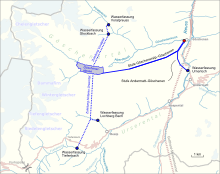Göschenen power plant
| Göschenen power plant | |||
|---|---|---|---|
| Service building and outdoor switchgear of the power plant | |||
| location | |||
|
|
|||
| Coordinates | 687 643 / 169080 | ||
| Waters | Göscheneralpsee , Reuss | ||
| Data | |||
| Type | combined high pressure - storage and hydropower plant | ||
| Primary energy | water | ||
| owner | Kraftwerk Göschenen AG owned by CKW (50%), SBB (40%) and Canton Uri (10%) | ||
| operator | CKW | ||
| Project start | 1944 | ||
| Start of operations | 1961 | ||
| turbine | 8 × Pelton turbine :
3 × 50 Hz national grid |
||
| Energy fed in per year | 372 GWh | ||
| Website | http://www.kw-goeschenen.ch/ | ||
| was standing | 2016 | ||
The power plant Göschenen is a combined high-pressure - storage and hydropower plant in the town of Göschenen in the canton of Uri . It processes the water of the Göscheneralpsee in storage operation and that of the Urnerloch water intake during operation. The management of the power plant, which generates both traction current for the SBB and 50 Hz alternating current for the national supply, is the responsibility of the Central Swiss Power Plants (CKW).
history
In 1907, the canton of Uri granted the Gotthard Railway Company a 50-year concession for the use of hydropower on the Reuss from the Urnerloch to Amsteg . The concession also included the Meienreuss , Fellibach and Kerstelenbach tributaries and passed to the Swiss Federal Railways (SBB) with the nationalization of the Gotthard Railway Company . In 1944 they gave the water rights for the Göschenen – Wassen section to the CKW, which also received a new concession valid until 2034 for the use of the Göscheneralpreuss and the Voralpreuss . After the plans for the Urseren power plant had been abandoned in 1951 , CKW and SBB also inquired about the use of the waters in the rear Urserental in 1952. CKW, SBB and the Canton of Uri founded the joint venture Kraftwerk Göschenen AG on February 16, 1955 . The project planning and construction of the power plant lasted from 1955 to 1962, with the construction management by Elektrowatt . In the middle section of the high valley, a reservoir was created that flooded the great Göscheneralp, the Göscheneralpsee . Because of the lake, 60 people from the hamlets of Älper, Boden and Mos had to be relocated.
technology
The machine groups are housed underground in a cavern that is 120 m long, 20 m wide and 30 m high and is 80 m in the mountain. The height is necessary for the removal of the rotors of the vertically arranged machine groups.
In front of the machine cavern is the slide valve cavity with the turbine gate valve . The service building with control room and workshop is arranged above ground. The SBB and CKW outdoor switchgear are located next to it.
Level Göscheneralp – Göschenen
This stage has been processing the water from the Göscheneralpsee since 1962. Its dam on the Göscheneralp is designed as a planted earth dam. The storage basin has a capacity of around 75 million cubic meters. A 7 km long pressure tunnel leads from the reservoir to the water lock and from there in a 900 meter long pressure shaft to the cavern power plant at the exit of the Göschenental.
Four machine groups with Pelton turbines with a nominal output of 40 MW each are used to generate electricity. Two generators generate traction power for the SBB, which is either fed into the 132-kV traction power network or via 66-kV lines to the SBB's Göschenen substation . The other two generators generate 50 Hz alternating current for the national supply, which is fed into the 220 kV level of the high-voltage network. In addition, this stage is used to operate a horizontally arranged machine group for self-supply, which has a nominal output of 650 kW.
Andermatt – Göschenen level
In addition to the water from the Göschneneralpsee, the power plant also draws water from the Urnerloch water intake in the Schöllenen Gorge, where part of the water from the Reuss is fed through a separate tunnel with its own water lock to the Göschenen power plant. This water has been processed in run-of-river power plants since 1961.
Two machine groups with Pelton turbines with a nominal output of 18 MW each are used to generate electricity. One generator generates traction current for the SBB, the other generator generates 50 Hz alternating current for the national supply, which is fed into the 50 kV and 15 kV level of the high voltage network. A horizontally arranged group of machines for self-supply is also operated with this stage, which has a nominal output of 650 kW.
See also
Web links
literature
- Fritz Ringwald : The Göschenen power plant. Geographic study of the utilization of the Reuss . In: Geographica Helvetica . tape 18 , no. 4 , 1963, pp. 305-314 , doi : 10.5169 / seals-44946 .
Individual evidence
- ^ Kraftwerke Göschenen AG: Kraftwerk Göschenen AG: History. In: www.kw-goeschenen.ch. Retrieved September 26, 2016 .
- ^ Fritz Ringwald: Das Kraftwerk Göschenen: Geographical study on the utilization of the Reuss . In: Geographica Helvetica . tape 18 , no. 4 , 1963, pp. 305-314 , doi : 10.5169 / seals-44946 .
- ↑ Susten Pass . In: Federal Office of Topography (Ed.): National map of Switzerland 1: 50,000 . Sheet number 255, 1954 ( Link ).






